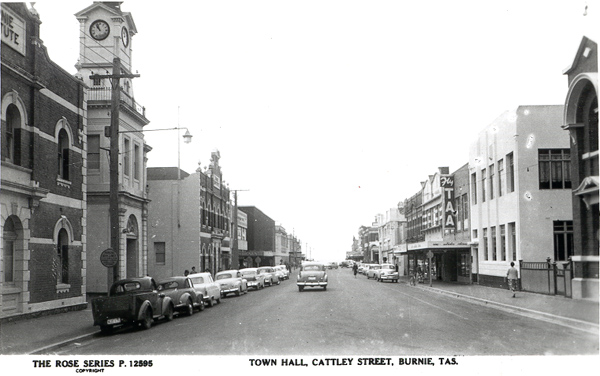 |
 |
|
Burnie
Burnie, on the shores of Emu Bay, was first settled in 1827 by the Van Diemen's Land Company's chief surveyor, Henry Hellyer, as a port to serve the Surrey and Hampshire native grasslands, fifty kilometres inland around St Valentine's Peak. Hellyer mistakenly believed the hills would provide ideal natural grazing land, and the Company selected 88,000 hectares in a vast swathe of the area. A year later the Emu Bay settlement consisted of a store, small jetty, sawpit and a few huts. A narrow dirt road was cut through dense rainforest to Company settlements in the hills. Surrey Hills proved a colossal blunder, thousands of expensive imported sheep dying from cold. By 1833 the blocks were virtually abandoned and only a few cattle stockmen remained at Emu Bay. In the 1840s the Company began leasing bush blocks to tenant farmers, but there were few takers. It started selling its land in and around the settlement, renamed Burnie after a Company director in November 1842. Sales were slow and Burnie stagnated. In 1880 its population was only 300. Burnie's fortunes took a dramatic turn for the better in the 1880s with the discovery of the west coast mineral deposits. In 1878 the Company built a horse-drawn wooden tramway – later upgraded to iron and steam – through its lands to the Mount Bischoff tin mine. Burnie became the port for the mine and its town of Waratah, and its population trebled by 1891. With the west coast mineral bonanza further south, the railway was taken over by the Emu Bay Railway Company and extended to Zeehan in 1900. This brought unprecedented growth of Burnie's business district and development of its outlying farms. By 1900 the town's population exceeded 1500. In the years leading up to the Second World War Burnie maintained steady, though not spectacular, growth. The establishment of Associated Pulp and Paper Mills in 1938 boosted its population to more than 10,000 in 1945. APPM's continuing expansion increased its workforce to about 3500 by the 1960s, and by then other major secondary industries, pigment producer Tioxide and North West Acid, had been established. These industries put Burnie on the road to city status in 1988, though there were serious pollution problems. The pigment and acid plants have since closed, and APPM (now Australian Paper) discharges only steam into the atmosphere and has no sea effluent. However, its workforce has been reduced to a few hundred. Further reading: K Pink, Campsite to city, Burnie, 2000; R Pike, Pioneers of Burnie, Burnie, 1977. Kerry Pink |
Copyright 2006, Centre for Tasmanian Historical Studies |
